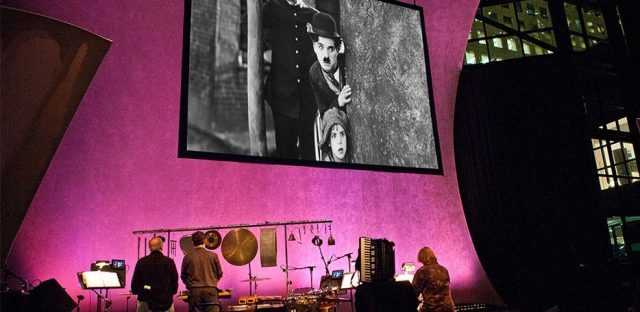
John Schaefer’s “Silent Films / Live Music” series returns to Brookfield Place this week
Brookfield Place
230 Vesey St.
January 30 – February 1, free, 7:30
www.artsbrookfield.com
In a 2011 twi-ny talk about his “Silent Films / Live Music” series at the World Financial Center Winter Garden, in which he selects silent movies to be accompanied by live scores, WNYC’s John Schaefer said, “The films seem less like period pieces themselves and more like a still-living art form.” After a hiatus, the program is back at Arts Brookfield, with Schaefer again running the show, reenergizing black-and-white silent cinema. On three successive nights, January 30 to February 1, Schaefer will present classic films with live accompaniment, beginning Wednesday with Marc Ribot performing to Charles Chaplin’s The Kid, followed Thursday by F. W. Murnau’s Nosferatu: A Symphony of Horror with music by Irene and Linda Buckley, and concluding Friday with series favorite Alloy Orchestra playing to Josef von Sternberg’s Underworld. Each screening begins at 7:30; admission is free.
THE KID (Charles Chaplin, 1921)
Wednesday, January 30, free, 7:30
www.artsbrookfield.com
 Charlie Chaplin’s first feature, The Kid, was a breakthrough for the British-born silent-film star, a touching and tender sixty-eight-minute triumph about a poor soul getting a second chance at life. When a baby arrives at his doorstep, a Tramp (Chaplin) first tries to ditch the boy, but he ends up taking him to his ramshackle apartment and raising him as if he were his own flesh and blood. Although he has so little, the Tramp makes sure the child, eventually played by Jackie Coogan, has food to eat, clothes to wear, and books to read. Meanwhile, the mother (Edna Purviance, Chaplin’s former lover), who has become a big star, regrets her earlier decision and wonders where her son is, setting up a heartbreaking finale. In addition to playing the starring role, Chaplin wrote, produced, directed, and edited the film and composed the score for his company, First National, wonderfully blending slapstick comedy, including a hysterical street fight with an angry neighbor, with touching melodrama as he examines poverty in post-WWI America, especially as seen through the eyes of the orphan boy, played beautifully by Coogan, who went on to marry Betty Grable, among others, and star as Uncle Fester in The Addams Family. Chaplin’s innate ability to tell a moving story primarily through images reveals his understanding of cinema’s possibilities, and The Kid holds up as one of his finest, alongside such other silent classics as 1925’s The Gold Rush and 1931’s City Lights. At Brookfield Place, Ribot will perform his 2010 score, which was commissioned for the New York Guitar Festival.
Charlie Chaplin’s first feature, The Kid, was a breakthrough for the British-born silent-film star, a touching and tender sixty-eight-minute triumph about a poor soul getting a second chance at life. When a baby arrives at his doorstep, a Tramp (Chaplin) first tries to ditch the boy, but he ends up taking him to his ramshackle apartment and raising him as if he were his own flesh and blood. Although he has so little, the Tramp makes sure the child, eventually played by Jackie Coogan, has food to eat, clothes to wear, and books to read. Meanwhile, the mother (Edna Purviance, Chaplin’s former lover), who has become a big star, regrets her earlier decision and wonders where her son is, setting up a heartbreaking finale. In addition to playing the starring role, Chaplin wrote, produced, directed, and edited the film and composed the score for his company, First National, wonderfully blending slapstick comedy, including a hysterical street fight with an angry neighbor, with touching melodrama as he examines poverty in post-WWI America, especially as seen through the eyes of the orphan boy, played beautifully by Coogan, who went on to marry Betty Grable, among others, and star as Uncle Fester in The Addams Family. Chaplin’s innate ability to tell a moving story primarily through images reveals his understanding of cinema’s possibilities, and The Kid holds up as one of his finest, alongside such other silent classics as 1925’s The Gold Rush and 1931’s City Lights. At Brookfield Place, Ribot will perform his 2010 score, which was commissioned for the New York Guitar Festival.
NOSFERATU: A SYMPHONY OF HORROR (NOSFERATU, EINE SYMPHONIE DES GRAUENS) (F. W. Murnau, 1922)
Thursday, January 31, free, 7:30
www.artsbrookfield.com
 In F. W. Murnau’s classic horror film, Max Schreck stars as Count Orlok, a creepy, inhuman-looking Transylvanian who is meeting with real estate agent Thomas Hutter (Gustav von Wangenheim) in order to buy a house in Germany. Hutter soon learns that the count has a taste for blood, as well as lust for his wife, Ellen (Greta Schröder), whom he has left behind in Germany. When Count Orlok, a bunch of rats, and a group of coffins filled with Transylvanian earth head out on a ship bound for Wisborg, the race is on to save Ellen, and Germany. Murnau’s Nosferatu is set in an expressionist world of liminal shadows and fear, as he and cinematographers Fritz Arno Wagner and Günther Krampf continually place the menacing Orlok in oddly shaped doorways that help exaggerate his long, spiny fingers and pointed nose and ears. Unable to acquire the rights from Bram Stoker’s estate to adapt the Gothic horror novel Dracula into a film, writer Henrik Galeen (The Golem, The Student of Prague) and director Murnau (Sunrise, The Last Laugh) instead made Nosferatu, paring down the Dracula legend, changing the names of the characters, and tweaking the story in various parts. Upon its 1922 release, they were sued anyway, and all prints were destroyed except for one, ensuring the survival of what became a defining genre standard-bearer. In 1979, German auteur Werner Herzog (Woyzeck, Fitzcarraldo) paid tribute to the earlier film with Nosferatu the Vampyre, a near scene-by-scene homage to Murnau’s original but with Stoker’s character names restored, as the book was by then in the public domain. Hans Erdmann’s complete score no longer exists, so numerous musical compositions have accompanied screenings and DVD/VHS releases over the years; at Brookfield Place, Irene and Linda Buckley will present the US premiere of their score.
In F. W. Murnau’s classic horror film, Max Schreck stars as Count Orlok, a creepy, inhuman-looking Transylvanian who is meeting with real estate agent Thomas Hutter (Gustav von Wangenheim) in order to buy a house in Germany. Hutter soon learns that the count has a taste for blood, as well as lust for his wife, Ellen (Greta Schröder), whom he has left behind in Germany. When Count Orlok, a bunch of rats, and a group of coffins filled with Transylvanian earth head out on a ship bound for Wisborg, the race is on to save Ellen, and Germany. Murnau’s Nosferatu is set in an expressionist world of liminal shadows and fear, as he and cinematographers Fritz Arno Wagner and Günther Krampf continually place the menacing Orlok in oddly shaped doorways that help exaggerate his long, spiny fingers and pointed nose and ears. Unable to acquire the rights from Bram Stoker’s estate to adapt the Gothic horror novel Dracula into a film, writer Henrik Galeen (The Golem, The Student of Prague) and director Murnau (Sunrise, The Last Laugh) instead made Nosferatu, paring down the Dracula legend, changing the names of the characters, and tweaking the story in various parts. Upon its 1922 release, they were sued anyway, and all prints were destroyed except for one, ensuring the survival of what became a defining genre standard-bearer. In 1979, German auteur Werner Herzog (Woyzeck, Fitzcarraldo) paid tribute to the earlier film with Nosferatu the Vampyre, a near scene-by-scene homage to Murnau’s original but with Stoker’s character names restored, as the book was by then in the public domain. Hans Erdmann’s complete score no longer exists, so numerous musical compositions have accompanied screenings and DVD/VHS releases over the years; at Brookfield Place, Irene and Linda Buckley will present the US premiere of their score.
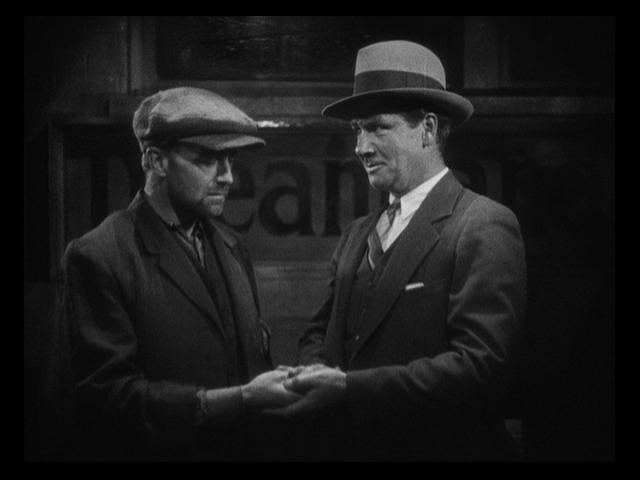
Bull Weed (George Bancroft) offers Rolls Royce (Clive Brook) a new life in Josef von Sternberg’s Underworld
UNDERWORLD (Josef von Sternberg, 1927)
Friday, February 1, free, 7:30
www.artsbrookfield.com
 The 2019 edition of “Silent Films / Live Music” has a grand finale February 1 with Alloy Orchestra performing to Josef von Sternberg’s 1927 silent black-and-white Underworld, generally considered the first modern gangster picture and a major influence on such films as William A. Wellman’s The Public Enemy and Mervyn LeRoy’s Little Caesar. Sternberg’s fourth film, Underworld is set in “a great city in the dead of night . . . streets lonely, moon-flooded . . . buildings empty as the cliff-dwellings of a forgotten age.” The opening shot is of a superimposed clock, emphasizing that it is two o’clock in the morning, a time when most are tucked safely in their bed at home. But not Bull Weed (George Bancroft), who has just pulled off a bank heist, only to be spotted by Rolls Royce (Clive Brook), a down-on-his-luck drunken bum. At Bull’s hangout, the Dreamland Café, his girl, Feathers (Evelyn Brent), enters, and a single strand from her extravagant getup floats down, the camera following it until it is grabbed by Rolls Royce, who is sweeping the floor. Bull’s main rival, Buck Mulligan (Fred Kohler), tries to get the attention of Feathers, upsetting his own moll, Meg (Helen Lynch). Walking out of the nightclub, Bull is greeted by an electronic billboard proclaiming, “The City Is Yours.” (Howard Hawks goes one better in his seminal 1932 film, Scarface, in which the title character, Antonio “Tony” Camonte, played by Paul Muni, is encouraged by an electronic sign that tells him, “The World Is Yours.”) Laughing, Bull playfully asks Feathers, “What’ll you have?” She scoffs at him, then Rolls Royce, a former lawyer, says, “Attila, the Hun, at the gates of Rome.” To which Bull replies, “Who’s Attila? The leader of some wop gang?” The stage has been set for the rest of the film, built around jealousy and envy as both Buck and Rolls Royce, who Bull decides to rehabilitate, fall hard for Feathers, but Bull is not about to just sit back and take it.
The 2019 edition of “Silent Films / Live Music” has a grand finale February 1 with Alloy Orchestra performing to Josef von Sternberg’s 1927 silent black-and-white Underworld, generally considered the first modern gangster picture and a major influence on such films as William A. Wellman’s The Public Enemy and Mervyn LeRoy’s Little Caesar. Sternberg’s fourth film, Underworld is set in “a great city in the dead of night . . . streets lonely, moon-flooded . . . buildings empty as the cliff-dwellings of a forgotten age.” The opening shot is of a superimposed clock, emphasizing that it is two o’clock in the morning, a time when most are tucked safely in their bed at home. But not Bull Weed (George Bancroft), who has just pulled off a bank heist, only to be spotted by Rolls Royce (Clive Brook), a down-on-his-luck drunken bum. At Bull’s hangout, the Dreamland Café, his girl, Feathers (Evelyn Brent), enters, and a single strand from her extravagant getup floats down, the camera following it until it is grabbed by Rolls Royce, who is sweeping the floor. Bull’s main rival, Buck Mulligan (Fred Kohler), tries to get the attention of Feathers, upsetting his own moll, Meg (Helen Lynch). Walking out of the nightclub, Bull is greeted by an electronic billboard proclaiming, “The City Is Yours.” (Howard Hawks goes one better in his seminal 1932 film, Scarface, in which the title character, Antonio “Tony” Camonte, played by Paul Muni, is encouraged by an electronic sign that tells him, “The World Is Yours.”) Laughing, Bull playfully asks Feathers, “What’ll you have?” She scoffs at him, then Rolls Royce, a former lawyer, says, “Attila, the Hun, at the gates of Rome.” To which Bull replies, “Who’s Attila? The leader of some wop gang?” The stage has been set for the rest of the film, built around jealousy and envy as both Buck and Rolls Royce, who Bull decides to rehabilitate, fall hard for Feathers, but Bull is not about to just sit back and take it.
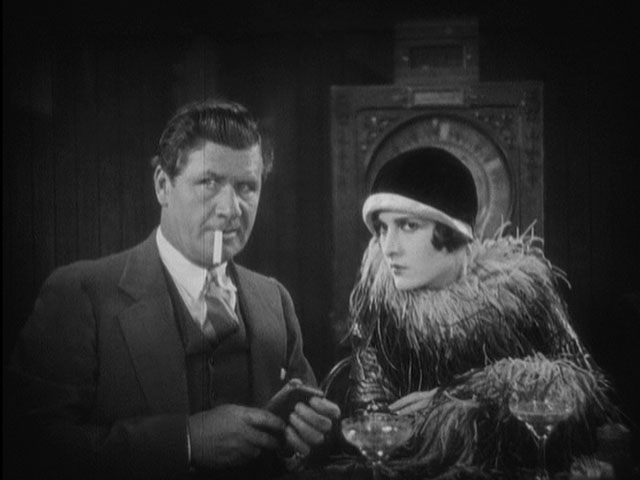
Bull Weed (George Bancroft) is protective of his moll, Feathers (Evelyn Brent), in classic gangster picture
Underworld is an expressionist noir melodrama that became the template for the gangster-film genre, launching many of the major tropes, from characterization to narrative development. It’s shot in shadowy glory by Bert Glennon (Lloyd’s of London, Rio Grande) from the dark streets to a glamorous annual armistice ball and a spectacular shootout finale. Journalist, novelist, and playwright Ben Hecht (Notorious, Wuthering Heights), who based Bull on real-life Chicago criminal “Terrible” Tommy O’Connor, won the Best Writing (Original Story) Academy Award at the first Oscars; Robert N. Lee wrote the screenplay, with the adaptation by Charles Furthmann and titles by George Marion Jr. Von Sternberg went on to make such classic sound films as The Blue Angel, Shanghai Express, Blonde Venus, and The Scarlett Empress with Marlene Dietrich. He directed only one full picture by himself after 1941, the 1953 Japanese war drama Anatahan; he died in Hollywood in 1969 at the age of seventy-five.
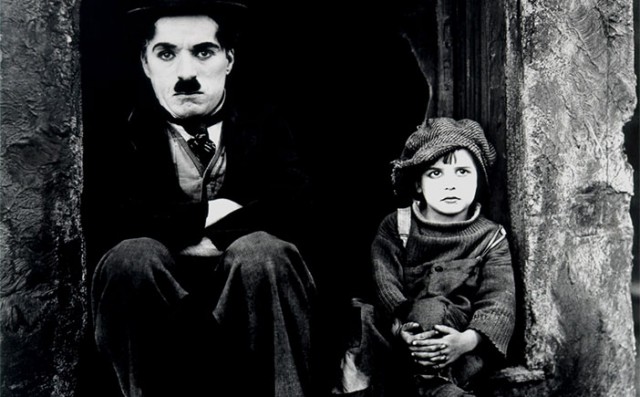
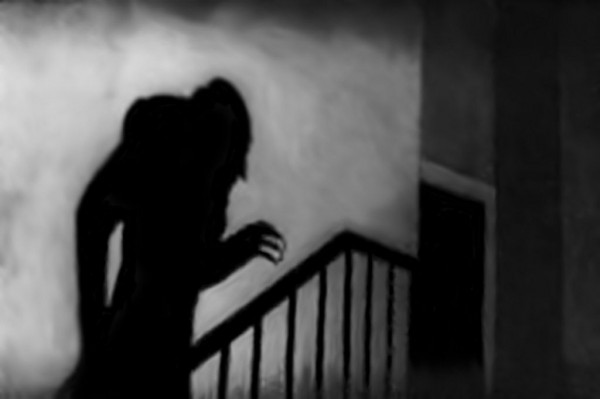
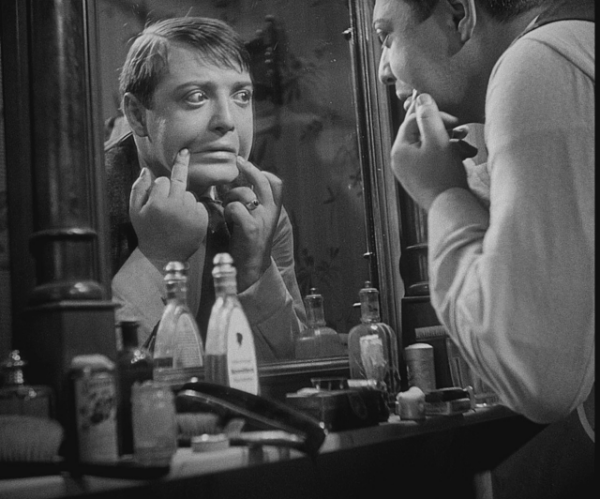

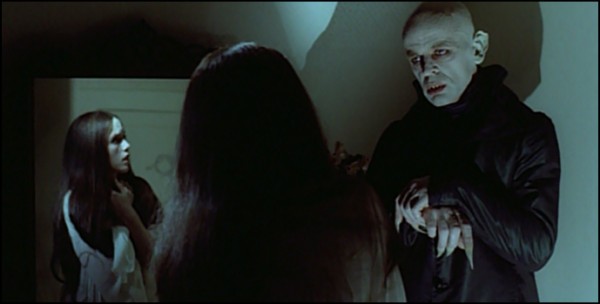
 Nearly sixty years after Murnau battled the Stoker estate, Herzog remade Nosferatu with an all-star cast featuring Bruno Ganz as real estate agent Jonathan Harker, Isabelle Adjani as his wife, Lucy, and Klaus Kinski as Count Dracula. Shot in flat colors by Jörg Schmidt-Reitwein and set to a score by German electronica band Popol Vuh, Herzog’s Nosferatu follows the same path as Murnau’s, as Jonathan Harker travels to Transylvania to have the count sign a contract, discovers that Dracula likes blood and sleeps in a coffin, then tries to save his wife when the count and thousands of (purportedly mistreated) rats sail to Wismar, renewing fears of plague. Kinski plays the count as a sad, lonely figure who no longer belongs in the modern world. He’s desperate for human contact, and his castle has seen much better days. Kinski often seems to be shot in black-and-white, surrounded by color, as if he were from another time, except for his shockingly red lipstick. It’s a virtuoso performance that is significantly more nuanced than Schreck’s, which is a more direct take on the character. Both films are gems; Film Forum is showing a new 35mm print of the rare German-language version of Herzog’s remake through November 7; on November 4 you can see them both, with separate paid admission.
Nearly sixty years after Murnau battled the Stoker estate, Herzog remade Nosferatu with an all-star cast featuring Bruno Ganz as real estate agent Jonathan Harker, Isabelle Adjani as his wife, Lucy, and Klaus Kinski as Count Dracula. Shot in flat colors by Jörg Schmidt-Reitwein and set to a score by German electronica band Popol Vuh, Herzog’s Nosferatu follows the same path as Murnau’s, as Jonathan Harker travels to Transylvania to have the count sign a contract, discovers that Dracula likes blood and sleeps in a coffin, then tries to save his wife when the count and thousands of (purportedly mistreated) rats sail to Wismar, renewing fears of plague. Kinski plays the count as a sad, lonely figure who no longer belongs in the modern world. He’s desperate for human contact, and his castle has seen much better days. Kinski often seems to be shot in black-and-white, surrounded by color, as if he were from another time, except for his shockingly red lipstick. It’s a virtuoso performance that is significantly more nuanced than Schreck’s, which is a more direct take on the character. Both films are gems; Film Forum is showing a new 35mm print of the rare German-language version of Herzog’s remake through November 7; on November 4 you can see them both, with separate paid admission.